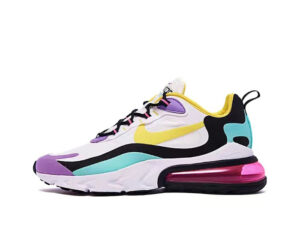The design and visual appeal of Nike Air Max shoes have evolved significantly over the years, reflecting changes in technology, fashion, and design trends.
Here is an overview of the evolution of the design and visual appeal of Nike Air Max shoes:
- 1980s – The Birth of Air Max: The original Nike Air Max 1, released in 1987, introduced the concept of visible Air cushioning. The design emphasized the visible Air unit in the heel, making it a central feature. Color schemes were relatively simple, with bright accents.
- 1990s – Bold Aesthetics: In the 1990s, Nike continued to innovate with models like the Air Max 90 and Air Max 95. The Air Max 90 featured bold panels and vibrant colorways. The Air Max 95 embraced unique layered designs and gradient color schemes.
- Late 1990s – Futuristic Designs: The late 1990s saw the release of the Air Max 97, known for its futuristic and sleek design inspired by bullet trains. It introduced reflective materials and metallic finishes.
- Early 2000s – Chunky and Bold: The Air Max 2003 and Air Max 180 featured chunky, performance-oriented designs with visible Air units. Color schemes varied from vibrant to more subdued.
- Mid-2000s – Retro Revival: During the mid-2000s, there was a resurgence of interest in retro Air Max models, leading to re-releases of classic designs. The Air Max 1 and Air Max 90 remained popular choices.
- Late 2000s – High-Tech Innovations: Nike continued to incorporate new technologies into Air Max shoes. The Air Max 360 featured a full-length Air unit for maximum cushioning, and Flywire technology was introduced for lightweight support.
- 2010s – Modern Silhouettes: Nike introduced contemporary silhouettes such as the Air Max 270 and Air Max 720, featuring large Air units and modern design elements. These models often incorporated sustainable materials and lightweight construction.
- Collaborations and Special Editions: Throughout the years, Nike collaborated with artists, designers, and brands to create limited-edition releases, adding unique visual elements and materials to Air Max models. These collaborations brought diverse aesthetics to the lineup.
- Customization and Personalization: Nike’s customization platform, NIKEiD (now Nike By You), allowed customers to design their own Air Max shoes, choosing colors, materials, and personalized details.
- Sustainability and Eco-Friendly Design: In response to environmental concerns, Nike introduced eco-friendly and sustainable materials in Air Max shoes, contributing to a more eco-conscious design approach.
- Innovative Materials: Nike incorporated advanced materials such as Flyknit, VaporMax, and React foam into Air Max models, offering improved comfort, support, and lightweight construction.
- Heritage and Throwback Releases: Nike celebrated the heritage of Air Max by re-releasing classic colorways and designs, catering to nostalgia and retro fashion trends.
The design evolution of Nike Air Max shoes showcases a balance between heritage and innovation, with an emphasis on comfort, performance, and aesthetics. China Air Max manufacturers The diverse range of models, styles, and technologies has allowed Air Max to remain a prominent and influential brand in both athletic and lifestyle footwear.
Are there any limited edition or special collaboration releases associated with the Nike Air Max line?
Yes, the Nike Air Max line has a rich history of limited edition and special collaboration releases. These unique and often exclusive partnerships with artists, designers, celebrities, and brands have produced some of the most sought-after and collectible Air Max sneakers. Here are a few notable examples:
- Nike x Off-White: Designer Virgil Abloh’s collaboration with Nike’s “The Ten” collection included the Air Max 90, Air Max 97, and other models. These sneakers featured deconstructed aesthetics, exposed materials, and signature text details.
- Nike x Travis Scott: Rapper Travis Scott collaborated with Nike on several Air Max models, such as the Air Max 1 and Air Max 270. His designs often feature bold colorways and unique branding elements.
- Nike x Atmos: The Japanese sneaker boutique Atmos has worked with Nike on various Air Max collaborations, known for their creative and eye-catching designs. The “Animal Pack” and “Elephant” Air Max 1 are iconic Atmos collaborations.
- Nike x Sean Wotherspoon: Designer and collector Sean Wotherspoon’s Air Max 1/97 hybrid, which won the “Vote Forward” competition, became a fan favorite with its vintage-inspired corduroy upper and vibrant color scheme.
- Nike x Parra: Dutch artist Piet Parra collaborated with Nike on Air Max models, including the Air Max 1 and Air Max 90. His designs feature colorful and abstract patterns.
- Nike x Patta: Amsterdam-based streetwear brand Patta has partnered with Nike on Air Max sneakers, such as the Air Max 1 and Air Max 90. These collaborations often pay homage to Amsterdam’s culture and heritage.
- Nike x Supreme: The streetwear brand Supreme has released a range of limited edition Air Max collaborations, incorporating its iconic logo and street-inspired designs.
- Nike x Skepta: British rapper Skepta collaborated with Nike on Air Max models, such as the Air Max 97 SK. His designs often reflect his Nigerian heritage and personal style.
- Nike x DQM (Dave’s Quality Meat): The New York-based retailer DQM collaborated with Nike on the Air Max 90 Bacon, known for its unique bacon-inspired colorway.
- Nike x CLOT: Hong Kong-based brand CLOT has collaborated with Nike on Air Max releases, featuring distinct materials and design elements influenced by Chinese culture.
- Nike x Kid Robot: The toy and apparel company Kid Robot collaborated with Nike on limited edition Air Max sneakers, combining sneaker and street art influences.
These collaborations and limited releases have added cultural and artistic dimensions to the Air Max line, making them highly sought after by collectors and sneaker enthusiasts. Each partnership often reflects the unique style and creative influence of the collaborating entity.
